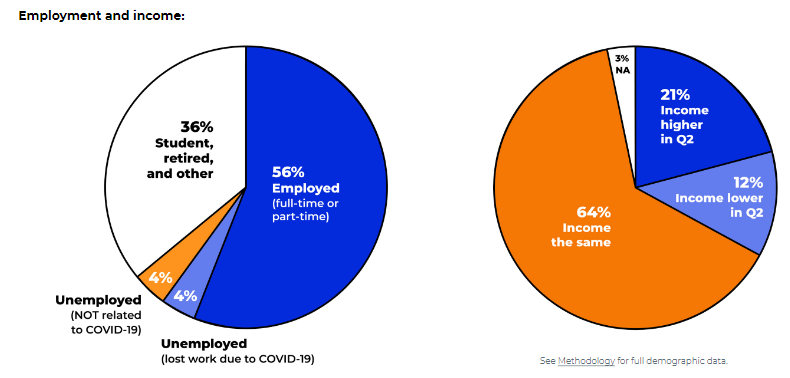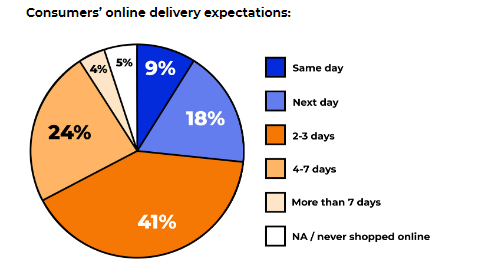Consumer Trends Q2 2021 | Jungle Scout
Warning: Undefined array key 0 in /home/dmc/public_html/wp-content/themes/DMC/single-report.php on line 19
Warning: Attempt to read property "name" on null in /home/dmc/public_html/wp-content/themes/DMC/single-report.php on line 19
|
USA
Understanding consumer trends is very important for businesses. Staying up to date with changes in consumer priorities and behavior makes you close to the consumer besides giving them the best experience they want.
In light of this, this report focuses on consumers’ attitudes and behaviors over the first quarter (January through March) and the second quarter (April through June) of 2021 and highlights how COVID-19 affected consumer behavior.
Q2 Insights: Consumer Preferences a Year into COVID
The COVID-19 pandemic touched every aspect of daily life, causing shifts in routines, work and income, housing, health-related behavior, social interactions, shopping, and many more
After a year full of dramatic events, the US consumers are on the track to rebuilding and return to their normal activities.
Compared to the previous quarter, consumers’ economic situations are showing signs of improvement.
According to the consumer trends report, only 4% are currently unemployed or furloughed due to COVID-19 — down from 8% when measured in Q1.
Moreover, only 12% of consumers say their household incomes are lower than they were three months ago — down from 22% in Q1.
The charts below show the employment and income change during the COVID-19 pandemic:

Delivery & Shipping During the Pandemic:
eCommerce is one of the industries that has grown during the pandemic. As consumers have grown to rely on and adopt eCommerce during the COVID-19 pandemic, expectations and attitudes towards delivery and shipping are evolving.
Online shoppers demonstrate an increased demand for fast and low-cost shipping.
- According to the consumer trends 2021 insights, 27% of consumers expect to receive something they’ve purchased online the same day or within the next day.
- On the other hand, two- to three-day shipping is seen as the standard for online orders with 41% of those surveyed saying that they expect to receive items purchased online within this timeframe.
- It is worth mentioning that fast shipping is essential. 47% of consumers would be willing to spend more for a product for faster shipping.
The chart below shows the consumers’ online delivery expectations:

Here’s the consumers’ observation of shipping speeds over the past year:
- Items arrive faster – 28%
- Shipping time is about the same – 38%
- Items arrive slower – 28%
- N/A – 6%
The Table of Contents of “Consumer Trends Q2 2021 Report”
- Ch.1 Q2 insights: Consumer preferences a year into COVID
- Ch.2 Trending spending: Consumer pulse report
- Ch.3 Ecommerce report
- Ch.4 Brand loyalty
- Ch.5 About the report
Number of Pages:
- 47 Pages
Pricing:
- Free
Methodology:
Between April 16-19, 2021, Jungle Scout conducted an anonymous survey among a panel of 1,066 U.S. consumers about their buying preferences and behaviors. Respondents represent every U.S. state, all genders, and ages 18 to 75+, as well as all employment types and varying income levels. The survey asked certain questions about behaviors during the ongoing COVID-19 pandemic, which is described as having started in the U.S. in March 2020 for consistency among related responses. The certain analysis also compares responses from this survey to the previous Consumer Trends Survey, where data was collected in January and covers a time span from October 2020 to March 2021. Q1 refers to the months of January through March 2021. Q2 refers to the months of April through June 2021.

Jungle Scout
Benefits of Using Jungle Scout:
- Whether you’re spying on competition or creating a selling strategy, the Product Tracker helps you find daily sales, inventory data, and revenue for any Amazon product.
- Get the leading all-in-one platform for finding, launching, and selling products on Amazon. Use Jungle Scout to make data-driven decisions and build your own successful business.
- Jungle Scout’s all-in-one platform empowers sellers with best-in-class features and insights that exceed Seller Central.
- Easily access market share data for any segment, see the size of your segment in dollar amounts, and view brand growth projections for your competitors.
The Top Features of Jungle Scout:
- Extension
- Keyword Scout
- Product Tracker
- Rank Tracker
- Opportunity Finder
- Listing Builder
- Product Database
- Review Automation
- Supplier Database
- Sales Analytics
- Academy
- Inventory Manager
- Alerts
- Promotions
- Category Trends
Jungle Scout Pricing:
- Monthly:
- Basic: $49/mo
- Suite: $69/mo
- Professional: $129/mo
- Yearly:
- Basic: $29/mo
- Suite: $49/mo
- Professional: $84/mo
Warning: Undefined array key "sidebar_ads" in /home/dmc/public_html/wp-content/themes/DMC/functions/helpers.php on line 824





